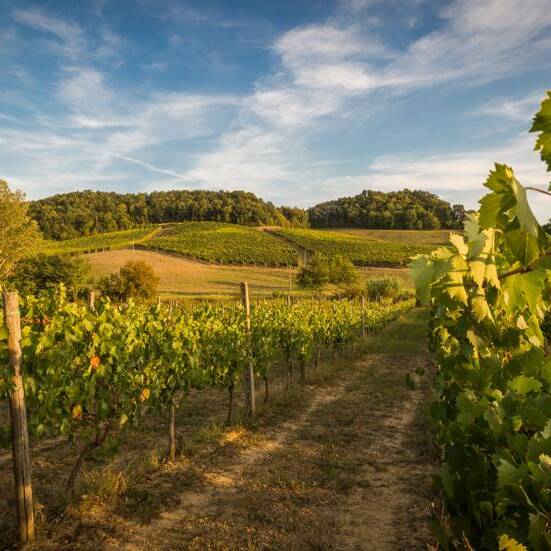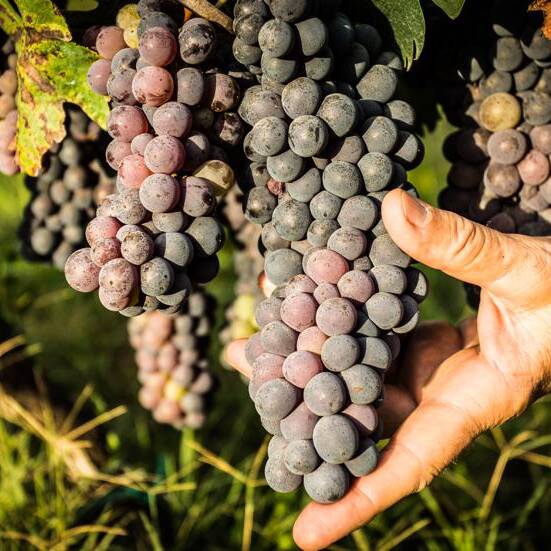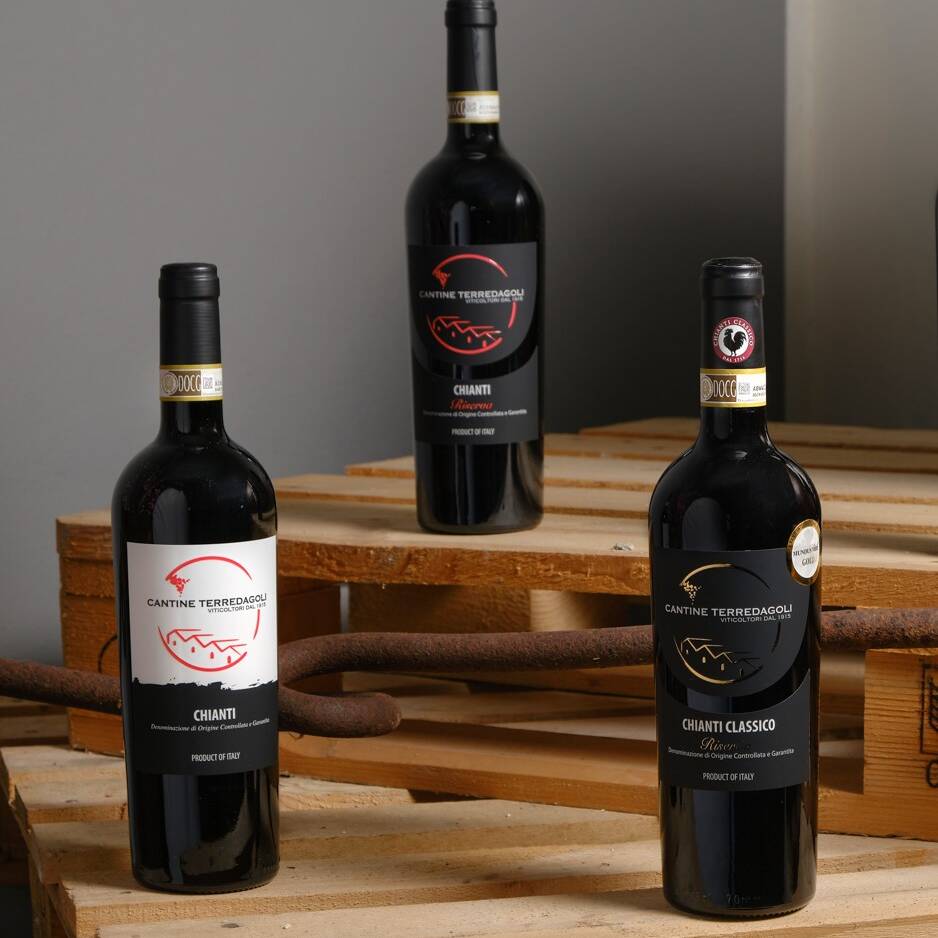Origins and History of Chianti Wine
Since antiquity, the Tuscan geographical area known as Chianti was inhabited by peoples dedicated to agriculture. It was the Etruscans who introduced the cultivation of vines, but it was only after the year 1000 that the area’s strong wine vocation developed. Today, the term Chianti is used to identify the wine production area and the wine itself. The first documents in which the name Chianti is associated with the wine produced in this area date back to the end of the 14th century. Over the centuries, the production and exportation of this wine increased dramatically, and it became necessary to regulate its production by adopting a form of protection based on geographical criteria within which the wine had to be produced in order to be called Chianti.
The Chianti wine region has precise environmental and topographical factors that, together with specific cultivation and vinification techniques, identify the characteristics that distinguish Chianti wine in terms of quality and uniqueness, and make Chianti a historic Tuscan wine, present on the market with two DOCG designations that protect it, Chianti and Chianti Classico. The Black Rooster, which according to legend was instrumental in defining the Chianti production boundaries in the struggle for domination of the territory between Florence and Siena, is the symbol historically adopted as the quality mark for Chianti Classico wine.
Italian Wine Denominations: DOCG, DOC and IGT

For wine, the label constitutes a true identity card for the product. It must in fact contain all the information that makes it immediately identifiable and enables the consumer to make a choice on the basis of its provenance and production method.
The main information for recognising a wine is its denomination. IGT, DOC and DOCG, are the acronyms that indicate that the wine comes from controlled supply chains.
The first distinction to be made, on the basis of EU regulations and national rules, is between Wine with Geographical Origin that has a territorial link and a specific specification, and Wine without Geographical Origin that has no particular production specification. For wines with Geographical Origin, controls are entrusted directly to accredited Certification Bodies.
IGT wines, with Indicazione Geografica Tipica, bear on the label the geographical indication of origin, the basic grape variety and the vintage year. These are wines from rather large production areas, almost all of whose grapes must be harvested from the geographical area of origin.
DOC wines, a Denominazione di Origine Controllata, are produced in a delimited geographical area of medium size, and must comply with very precise characteristics set by their own regulations, ranging from the grape varieties that can be used to the minimum alcohol content that the wine must have, to the type and time of ageing.
Even stricter are the rules imposed, both at the production and bottling stages, for DOCG wines, Denominazione di Origine Controllata e Garantita. This is the highest qualification in the wine sector given to DOC wines of particular value, recognisable for their characteristics nationally and internationally. This is the case, for example, of Chianti Classico.
The fact that a wine belongs to a denomination is not only a form of quality guarantee to protect the consumer, it is also an acknowledgement of the producers’ commitment to producing a recognised and certified quality product.
Chianti Grape Varieties

The most widespread native grape variety in the Chianti region is Sangiovese, of which there are different qualities, Prugnolo Gentile, Sangiovese Piccolo and Sangiovese Grosso.
It is a vine that adapts to different soils, clay and limestone, giving rise to wines with different characteristics. A vine whose characteristics and personality contribute to the creation of wines with a unique and unmistakable character. Since ancient times, Sangiovese has been used for the production of a wine with a red colour tending to garnet, a soft taste, scented with spices and berries, known for its freshness and liveliness. Over time, this grape variety became the undisputed protagonist in the production of Chianti wine, present in percentages that must not fall below 80% for Chianti Classico.
The other grapes that make up Chianti wine come mainly from black grapes: Canaiolo, which already appeared in the original recipe for Chianti Classico codified by Baron Bettino Ricasoli in 1872; Colorino, an indigenous Tuscan vine from the cultivation of wild grapes that was used in the past to give colour to the wine; Cabernet Sauvignon, a grape variety originating in France but very widespread in Tuscany, able to adapt very well to hilly and not very fertile soils, and to different climatic conditions; Merlot, also a prized grape variety originating in France, is resistant to damp and clayey soils, and can easily be cultivated in Tuscany. Two white grapes, Trebbiano and Malvasia, are also allowed in a very small percentage for the production of Chianti wine.
The most widespread native grape variety in the Chianti region is Sangiovese, of which there are different qualities, Prugnolo Gentile, Sangiovese Piccolo and Sangiovese Grosso.
It is a vine that adapts to different soils, clay and limestone, giving rise to wines with different characteristics. A vine whose characteristics and personality contribute to the creation of wines with a unique and unmistakable character. Since ancient times, Sangiovese has been used for the production of a wine with a red colour tending to garnet, a soft taste, scented with spices and berries, known for its freshness and liveliness. Over time, this grape variety became the undisputed protagonist in the production of Chianti wine, present in percentages that must not fall below 80% for Chianti Classico.
The other grapes that make up Chianti wine come mainly from black grapes: Canaiolo, which already appeared in the original recipe for Chianti Classico codified by Baron Bettino Ricasoli in 1872; Colorino, an indigenous Tuscan vine from the cultivation of wild grapes that was used in the past to give colour to the wine; Cabernet Sauvignon, a grape variety originating in France but very widespread in Tuscany, able to adapt very well to hilly and not very fertile soils, and to different climatic conditions; Merlot, also a prized grape variety originating in France, is resistant to damp and clayey soils, and can easily be cultivated in Tuscany. Two white grapes, Trebbiano and Malvasia, are also allowed in a very small percentage for the production of Chianti wine.

The difference between Chianti, Chianti Classico and Chianti Riserva

Chianti is a Tuscan red wine, of which there are two different DOCGs, Chianti and Chianti Classico, governed by different regulations.
The first difference between Chianti wine and Chianti Classico lies in the territory of origin. In the 18th century, the Grand Duke of Tuscany defined the boundaries for the production of this wine within the region, an area between the cities of Florence and Siena that encompassed the municipalities of Greve in Chianti, Barberino di Val d’Elsa, Tavarnelle Val di Pesa, San Casciano in Val di Pesa, Castellina in Chianti, Gaiole, Radda and Castelnuovo Berardenga; in the 20th century, when the demand for this wine grew enormously, its production also began to be carried out in the neighbouring territories, making it necessary to protect the original producers. It is since then that one speaks of Chianti Classico, the one produced in the historical borders, and Chianti produced also in territories further away and outside the region. Only Chianti Classico was associated with the historic Black Rooster mark.
Territory is not the only element that determines the difference between Chianti and Chianti Classico. What is different is the specification, i.e. the regulation that must be respected by the producer in order to obtain certification.
Both wines are made from Sangiovese grapes, 70% in Chianti, while the figure rises to 80% in Chianti Classico; the remaining grapes are a blend of complementary red varieties such as Cabernet Sauvignon, Merlot, Canaiolo and Colorino in different percentages. The alcohol content is also different, ranging from a minimum of 12° in the Chianti to 13° in the Chianti Classico and up to 13.5° in the Chianti Riserva; the ageing times are also different, ranging from 6 months in the Chianti to 12 months in the Chianti Classico and 24 months in the Chianti Riserva.
Chianti Classico Riserva is considered a more noble wine. Its quality depends on the vintage year and the grapes, only the best will be destined to become Chianti Classico Riserva.

